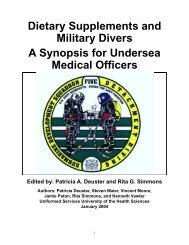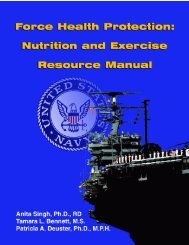Traumatic Brain Injury and Effects of Altitude - Human Performance ...
Traumatic Brain Injury and Effects of Altitude - Human Performance ...
Traumatic Brain Injury and Effects of Altitude - Human Performance ...
Create successful ePaper yourself
Turn your PDF publications into a flip-book with our unique Google optimized e-Paper software.
<strong>Traumatic</strong> <strong>Brain</strong> <strong>Injury</strong> (TBI) <strong>and</strong> <strong>Effects</strong> <strong>of</strong> <strong>Altitude</strong>:An Analysis <strong>of</strong> the Literatureextreme altitude, the three climbers who were most severely impaired also demonstrated EEGabnormalities suggestive <strong>of</strong> irreversible hypoxic damage in fronto-temporal limbic (hippocampal) brainstructures. Other investigators have reported similar evidence <strong>of</strong> lasting effects <strong>of</strong> extreme altitudeexposure on cognitive function (Garrido et al., 1993, 1996; Hornbein et al., 1989).Temporary neuropsychological impairments have also been observed in climbers who have reachedextreme altitudes with the use <strong>of</strong> supplemental oxygen (Clark et al., 1983; Lowe et al., 2007; Townes etal., 1984), <strong>and</strong> in volunteers subjected to artificial altitude in the laboratory setting (Ledwith, 1968). Thissuggests that effects <strong>of</strong> altitude on cognitive performance are probably mediated by hypoxia <strong>and</strong> thatsupplemental oxygen may play a critical role in preventing permanent damage from sustained orrepeated hypoxic insult to the brain.Military Concerns <strong>and</strong> Operational ConstraintsMilitary medics, physicians <strong>and</strong> surgeons must be aware <strong>of</strong> many direct <strong>and</strong> indirect environmentalthreats to the survival <strong>of</strong> injured soldiers. Because the human brain is susceptible <strong>and</strong> sensitive tophysiological change, medical caregivers need to know what, if anything can be done to avoid ormitigate the potentially harmful effects <strong>of</strong> time <strong>and</strong> environment on military casualties in whom TBI isknown or suspected. The Guidelines for the Field Management <strong>of</strong> Combat-Related Head Trauma (Knuthet al., 2005) emphasized the importance <strong>of</strong> monitoring <strong>and</strong> preventing hypoxemia <strong>and</strong> hypotension,both <strong>of</strong> which have been identified in different studies as independent predictors <strong>of</strong> poor outcome inbrain-injured patients (Chestnut et al., 1993; Manley et al., 2001). There is also a need to betterunderst<strong>and</strong> the possible long-term health <strong>and</strong> performance implications for warfighters who recoverfrom concussion or TBI <strong>and</strong> then return to duty in high-altitude settings.TBI can be uniquely difficult to manage effectively in combat settings, which introduce myriad additionalrisks to the survival <strong>of</strong> injured military personnel <strong>and</strong> those who provide for their acute medical care <strong>and</strong>transport. For example, operational constraints may make it impossible to provide immediate or directtransport from the battlefield to a trauma center with neurosurgical capabilities. Delay itself canincrease the risk <strong>of</strong> secondary injuries. In addition, the potentially harmful effects <strong>of</strong> rapid ascent to highaltitude on critically ill <strong>and</strong> injured patients introduce yet another complex hazard for casualties who areevacuated by aeromedical transport, <strong>and</strong> for the flight crews who care for them.Military medical flights transporting warfighters from combat zones to medical care centers in Europe orthe U.S. can last for many hours. During this time, patients are exposed to multiple sources <strong>of</strong>physiologic stress, including hypoxia, dehydration <strong>and</strong> cold temperatures. Even with the benefit <strong>of</strong>training <strong>and</strong> redundant protective systems in place, fliers <strong>of</strong> military aircraft do sometimes experiencepotentially deadly hypoxia (Cable, 2003). Although the risks associated with aeromedical transport arenot new to those who practice emergency <strong>and</strong> military medicine, mitigating <strong>and</strong> controlling theirpotentially dangerous effects requires knowledgeable preparation <strong>and</strong> management, adequateresources <strong>and</strong> careful attention to patient status (Argyros & Cassimatis, 2002; Barnes et al., 2008;Helling & McKinlay, 2005; Johannigman, 2007, 2008; Letarte et al., 1999; Morris, 1992; Reddick, 1977;Turkan et al., 2006).Military personnel who have experienced multiple concussions or are considered to have recoveredfrom TBI are <strong>of</strong>ten returned to active duty, where they may fly in non-pressurized aircraft <strong>and</strong>/or be re-September 14, 2010 12



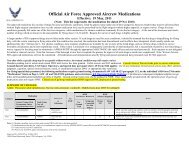
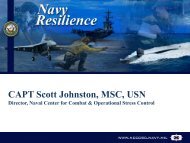
![Body Composition and Military [PDF] - Human Performance ...](https://img.yumpu.com/43269347/1/190x245/body-composition-and-military-pdf-human-performance-.jpg?quality=85)
![Tips for Grocery Shopping [PDF]](https://img.yumpu.com/37447379/1/190x245/tips-for-grocery-shopping-pdf.jpg?quality=85)
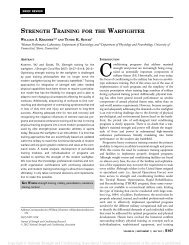
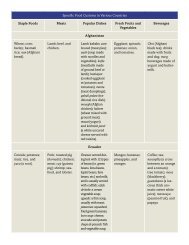
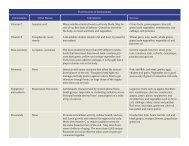
![Synthetic Drugs [PDF] - Human Performance Resource Center](https://img.yumpu.com/37447322/1/190x245/synthetic-drugs-pdf-human-performance-resource-center.jpg?quality=85)
